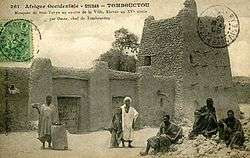Sidi Yahya Mosque
Sidi Yahya is a mosque and madrassa of Timbuktu in Mali which finished construction in 1440. Sidi Yahya along with Djinguereber and Sankore compose the "University" of Timbuktu. Sidi Yahya's mausoleum was destroyed on 2 July 2012 following the Battle of Gao and Timbuktu. The sacred legend of this holy site states that the "End of The World" main gate of Sidi Yahya mosque would not be opened until the last day (of the world), or end times.[1]

History
Sidi Yahya is named for its first imam and head professor Sidi Yahya (also called Sidi Yahya Tadelsi or Sidi Yahya Al Andulusi). The mosque is located south of the more famous Sankoré Mosque. Construction of the Sidi Yahya mosque was begun in 1400 by Sheikh El-Mokhtar Hamalla in expectation of a great holy person. It took 40 years to complete. In 1441 Mohamed Naddah, the city-governor of Timbuktu, appointed his close friend Sidi Yahya as its first imam. This marked the beginning of the mosque as a madrassa and a great center of learning for the region.
Changes
The Sidi Yahya mosque was restored in 1577 or 1578 by Cadi Al Akib. Its original shape was altered in 1939 to reduce its appearance as a military fortress. The original minaret, however, is still in place. Beneath it are the sepulchres of Sidi Yahya and Mohamed Naddah who are said to have died one week apart. The doors of the mosque were also repaired.
Notable features
Sidi Yahya closely resembles the other famous mosques in Timbuktu (Sankore and Djinguereber). Key differences are it is not as tall and the doors are ornately made reflecting Moroccan influence. The mosque has three rows of pillars facing north-south. The main courtyard is located in the southern part of the city and towered over by the minaret. The courtyard was converted into a cemetery that is no longer in use. The imams of the school are buried in an underground area located to the north of the mosque. Evening and morning prayers are performed there. It also contains lodgings for the mosque’s guard. A smaller, external courtyard is used as reading space during the celebration of the birth of Prophet Muhammad. Compared to other mosques of Timbuktu, this one benefits from greater care and maintenance.
Desecration
In the summer of 2012, members of Ansar Dine broke down the doors of the mosque, which according to legend were not to be opened until the end times. They claimed that the reverence for the site was idolatrous, but offered roughly $100 US dollars to repair the mosque.[1]
References
- Defiant Mali Islamists pursue wrecking of Timbuktu, Reuters, 2 July 2012.